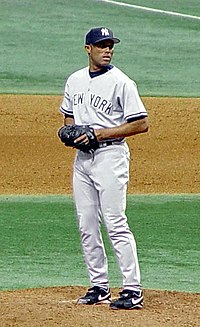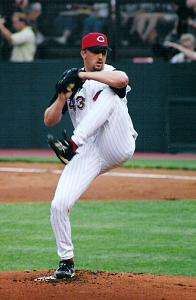Pitching position
In baseball, there are two legal pitching positions: the windup, and the set. Colloquially, the set is often referred to as "the stretch", although this term actually only refers to one part of the pitching motion when pitching from the set.[1]
Both types of pitching position have their strengths and weaknesses. Compared to the set, the windup has a relatively slower execution, so therefore is better suited for situations in which there are no baserunners, or when the lead runner is on third base, since it is difficult to steal home plate. Conversely, a pitch from the set, having a relatively faster execution, is preferred when there are baserunners. Faster execution is important to prevent stolen bases.
However, some pitchers, particularly relief pitchers, are more comfortable pitching from the set position, and thus use it regardless of the situation.

A pitcher is in the windup when, with the ball, the pitcher stands on or directly in front of the pitching rubber, located at the top of the mound, with his feet pointing toward home plate. Prior to throwing a pitch, the pitcher has the option of taking one step back toward second base or to either side, using his free leg (left leg for a right-handed pitcher). During the delivery of the pitch, the pitcher must take one step forward, in the direction of home plate. Alternatively, the pitcher may step off the rubber with his pivot foot (the right foot, for right-handed pitchers) or step toward and throw or feign a throw to a base, subject to the balk rules. In the windup, the time of pitch is the instant when one of the following occurs: the pitcher commits to taking a step backward, or he takes a step to the side, or brings his hands together.

A pitcher is in the set when, with the ball, he stands on, or directly in front of—and touching—the pitching rubber, with his toes pointing toward the side (toward third base for a right-handed pitcher) and his arms apart at his sides. This initial part of the set is called the stretch, because the pitcher usually stretches toward home plate to take signs from the catcher. At this point, the pitcher may make any number of preparatory movements necessary for delivering the pitch. Delivery begins when the pitcher brings his arms together in front of his body (a movement punctuated with a discernible pause). This is called coming set. After coming set, the pitcher takes a step toward home and delivers the pitch. Typically, pitchers from the set use a high leg kick, thus lunging toward home in pitching; a pitcher may instead release the ball more quickly by using the slide step, quickly stepping directly and immediately toward home and pitching. In the set position, the time of pitch is that instant when the pitcher makes a move toward home plate after coming set.
As with the windup, prior to the time of pitch, the pitcher may step toward and throw or feign a throw to a base, subject to the balk rules, or disengage the rubber by stepping back (toward second base) with his pivot foot.
Impact
Data analysis indicates that pitch velocity is equivalent whether thrown from the windup or the set position.[2]
Additionally, common wisdom is that the set is less damaging to the connective tissue of a pitcher's arm, but research in this area has been unable to support this hypothesis.[3]
References
- Ellis, Steven. "Pitching Mechanics". Retrieved 11 December 2011.
- Fast, Mike (2010-04-20). "Does the Stretch Cost a Pitcher Fastball Speed". Hardball Times. Retrieved 11 December 2011.
- Shouchen, Dun; David Kingsley; Glenn S. Fleisig; Jeremy Loftice; James R. Andrews (January 2008). "Biomechanical Comparison of the Fastball From Wind-Up and the Fastball From Stretch in Professional Baseball Pitchers". American Journal of Sports Medicine. 36 (1): 137–141. doi:10.1177/0363546507308938. PMID 17986632.